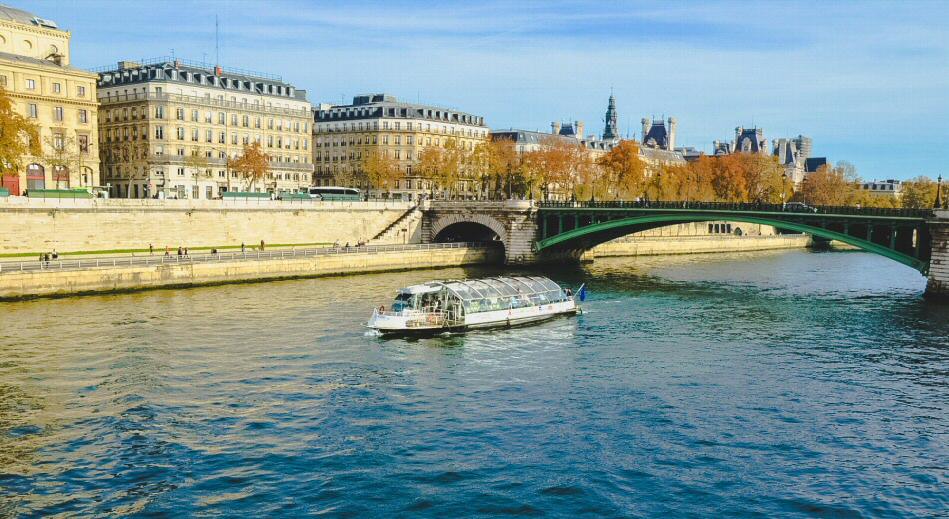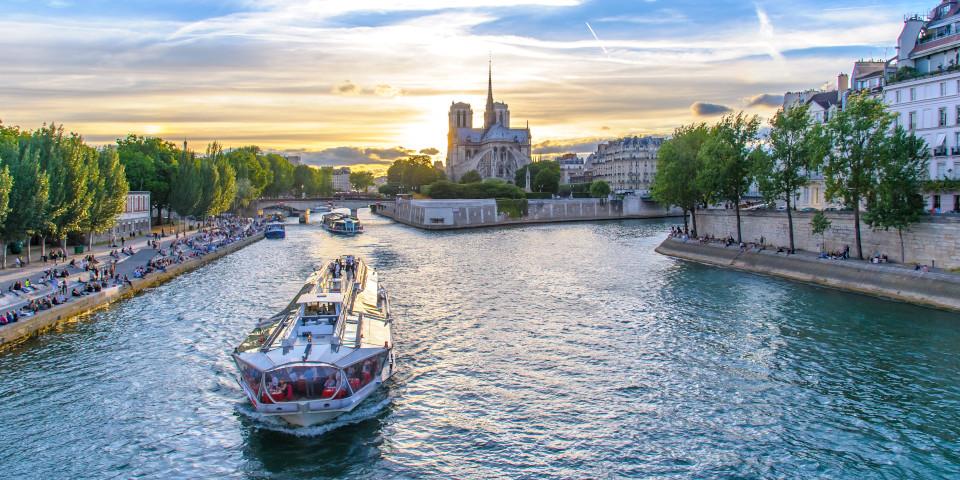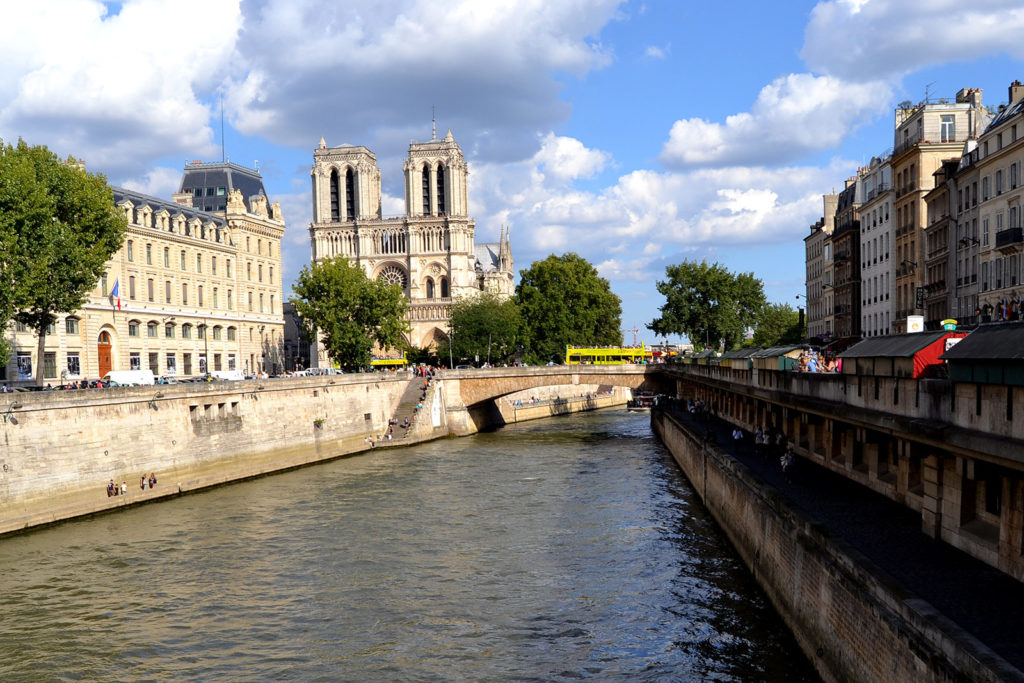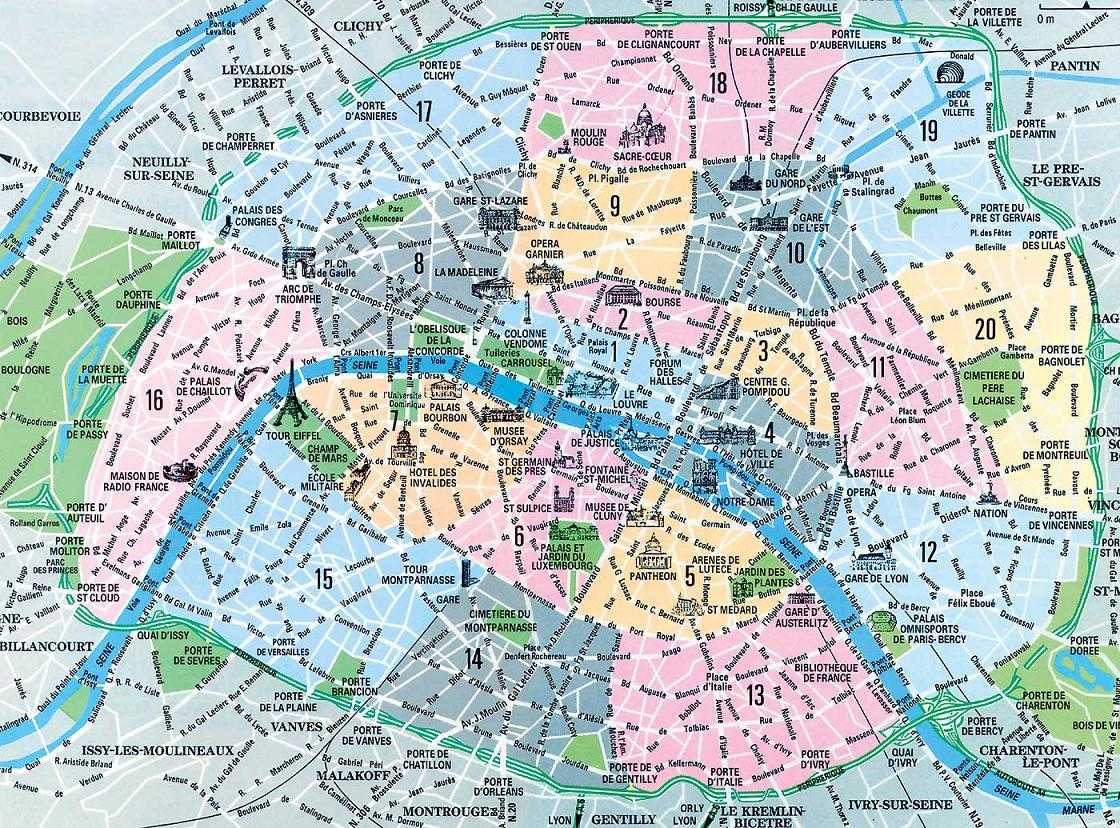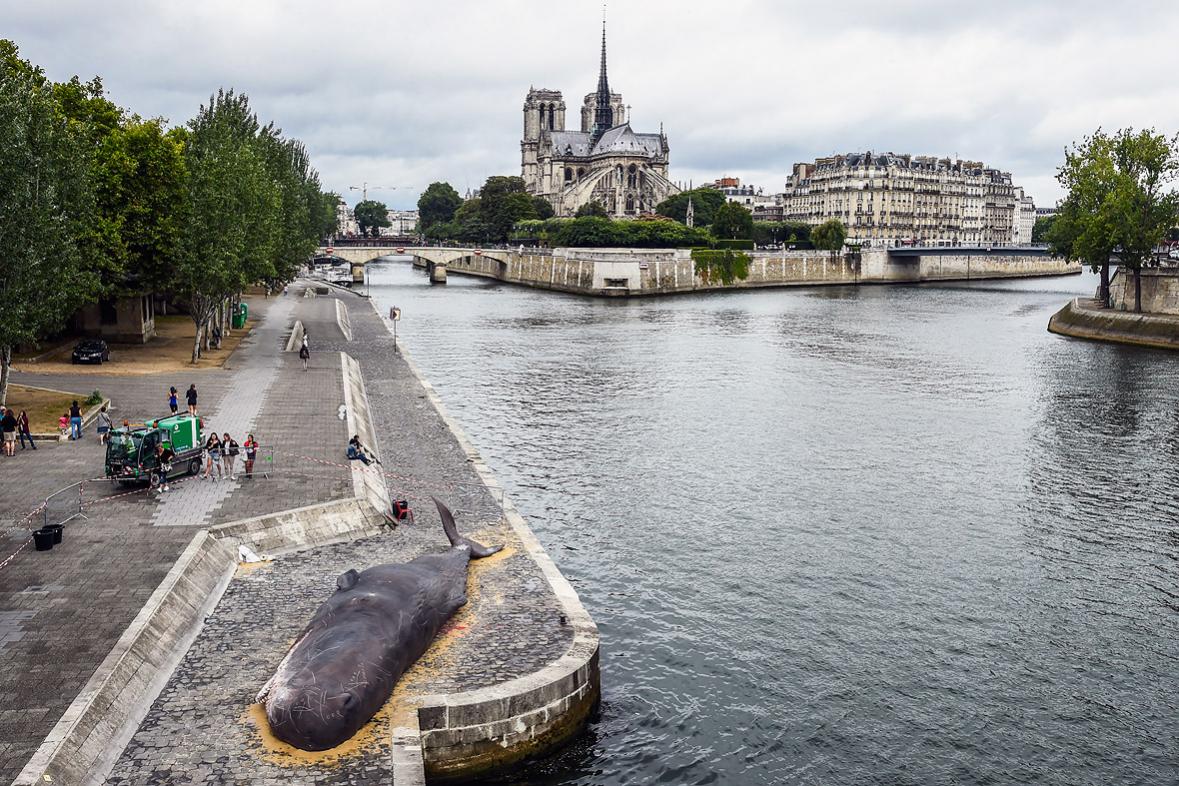Who has not heard of Seine river?, or Seine in French. It is the most relevant and remarkable river in France, not only because of its history, the course it takes, the commercial movement it has promoted and its great tourist attraction. We invite you to read this article and learn more about this majestic river.
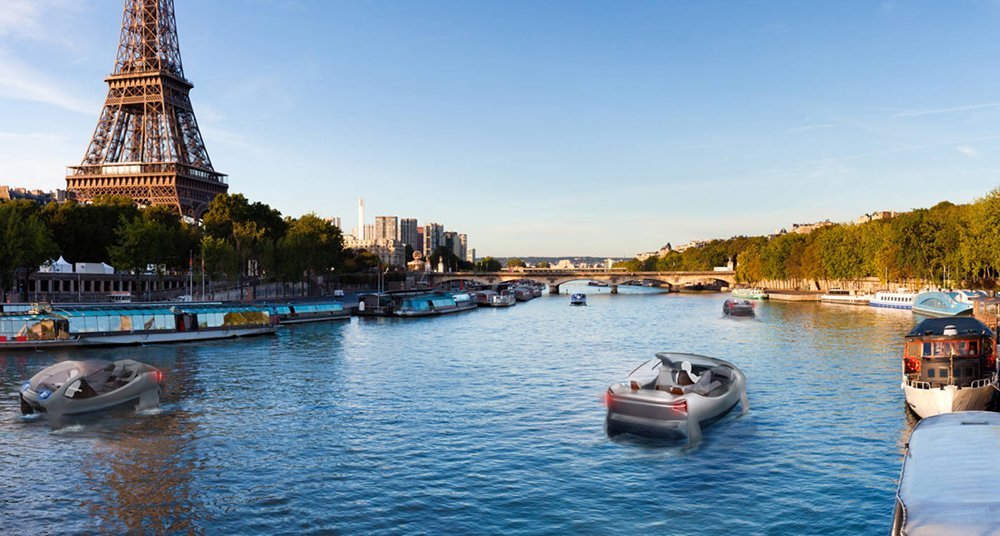
History of the Seine River
History Seine river, in French Seine, which used to be called Sequana, is undoubtedly a very interesting story, because it is not only related to relevant aspects that had an impact on the foundation and development of well-known populations on the European continent, but also the very Rio has witnessed all kinds of happenings and events that cover the catalog of all the possibilities of humanity. From the most lofty, such as letters and art, to the most relevant historical events that have produced changes in the way of being and thinking.
It could be said that the Seine River is as well known as the Nile, or as the Amazon River and as sublime as the Danube and with so many centuries of experiences, it has been the forerunner of the exponential growth that cities like Paris have had. For this reason, its inhabitants, when referring to the Ile de la Cité, have adopted the motto related to the Seine that surrounds it, according to which the city floats, but does not sink.
But the River Seine not only crosses Paris, a city for which it has been the inspiration for numerous dream bridges that cross it, both for pedestrians and for vehicle traffic. The Seine flows through many important cities in France, such as Troyes, Melun and Rouen. But the fate of the Seine is inseparable from the capital, Paris. It can be said that there is an indestructible link between Paris and the Seine. In fact, it is said that Paris itself would not exist without it, since the beginnings of the city of light could have been possible thanks to the security cordon that extended the Seine around the Ile de la Cité.
Birth of Paris
Paris was born on that island, surrounded by the river, on which the kings of yesteryear built their castles and temples, turning them into impregnable fortresses thanks to the protection of the Seine. There are countless stories, myths and legends that make up the history of the Seine River, and that confer an existence and a poetic and almost novel environment. So much has been written about its banks and the events that have had it as a stage, that it could be said that at some moments in history, the Seine has taken on a life of its own.
Legends
One of the legends associated with the River Seine is that the ashes of Joan of Arc, the famous French martyr, were scattered in the Seine after she was burned on the cross for heresy in 1431. Napoleon Bonaparte's last wish , expressed in his will, was that his mortal remains were transferred from the Elba Castle, where he remained confined, and were buried on the banks of the Seine. Of course, such a request was not fulfilled.
But not everything has been romantic or acts of chivalry. The Seine has also witnessed acts of a brutal nature, as evidenced by being the object of the Nazi invasion during the Second World War, losing almost its entire population of Jewish faith and, more recently, the massacre of Paris, which occurred in 1961. , when the Prefect of Police attacked a peaceful demonstration of Algerians living in that city, who are known by the nickname of French black feet, whose victims drowned when they were thrown into the river from the Saint-Michel bridge and other locations in the capital city.
Second World War
Going back to World War II, the Seine River was the fundamental axis through which the allies against Germany intended to invade France. So it was done and it was called Operation Overlord. According to the plans, it would take only 90 days for the allies to invade France and dislodge the German army, using the Seine as the main transport route in 1944. But history showed that not only was the operation successful, but also the success was resounding, because they achieved the objectives in much less time than had been thought, due to the flight of the German army in the month of August of that year.
Art, Engineering and Architecture
The Seine River has not only carried out the role of inspiration for great artistic and literary works, but has also been a challenge for the sciences, in the case that we want to mention, specifically for engineering, when the experts achieved in the year 1960 stop what was known as Le Mascaret, an achievement that made it possible to stop the tides and waves in the Seine, through ingenious inventions for dredging.
We cannot ignore the fact that the Seine River has also been a great source of architectural inspiration. The jewels that have been built over the centuries on its banks have given it an individual character, and true milestones in history have taken place there.
Examples of emblematic buildings on the Seine are the Eiffel Tower, a Parisian icon built in 1889 for the world exhibition, the Luvre Museum, Place de la Concorde, the Grand and Petit Palais, the Arc de Triomphe, the Haussmann boulevards, They are just a few of the models of the abundance of architectural jewels that the Seine guards.
Threats
Coexistence with the River Seine has also been a threat to Paris. In the month of January of the year 1910, the water levels suffered a great increase, so high that important floods took place. This activity of increasing the flow of the Seine has been constant and became a serious threat again in the years 1924, 1955, 1982 and 1999 and 2000, in which the river again reached dangerous levels, to later give way to alerts of emergency in the city of Paris due to possible flooding.
The threat was such that in 2003 around one hundred thousand works of art had to be moved out of Paris, a fact that constituted the largest artistic transfer since the time of the Second World War. Since ancient times, it has been a custom to keep a huge proportion of the existing art in Paris in underground vaults, but if the level of the River rises alarmingly, they could suffer floods.
According to studies dating back to 2002, if such an event occurred, it would represent a loss of around ten billion euros, as well as having to suspend public services, leaving a large part of the population without electricity, gas and telephone. the Parisian population.
Roman age
The Seine River has witnessed historical events since time immemorial. Beneath the surface of La Ile de la Cité, next to the unfortunately ill-fated Notre Dame Cathedral, it is still possible to see what remains of the Gallo-Roman settlement that stood there millennia ago, to be able to live in an environment that is very different from the current one. . Archaeological investigations have shown that the canoes that were found in that locality, whose date of manufacture is more than 6000 years ago, indicate that this primitive settlement adapted very well to the banks of the river and to that lifestyle.
The Seine River was also an excellent teacher for the Romans, who had to learn to build solid bridges to reduce the risks of the water currents that flowed in the rivers of the conquered regions, but with the Seine they learned to take advantage of the places in which there were islands that divided the currents of the rivers into two or more parts, having to build sectional bridges to give greater solidity to the surface and obtain fluid river traffic, without obstacles, making it the main supplier of the basic requirements for the development and livelihood.
Thanks to the knowledge learned and the implementation of this excellent strategy, large and flourishing cities began to be established, with excellent potential in terms of trade. The city of Paris is an example of one of these assumptions, because it is an island that is located in the middle of the river current, which provided many facilities for the construction of large-scale works and optimized commercial development.
outline the silhouette of the city
Both today and in times past, the River The Seine continues to be linked to Paris and Paris is linked to its river. The current divides that beautiful capital, which was the birthplace of extraordinary artists and the place where other famous creators developed their art, into two parts, where we can find the most splendid works of art and buildings on earth. , and over the gentle flow of its waters, we will find a multitude of bridges, which in themselves also turn out to be extraordinary works in all styles.
Of course, canoes are no longer seen on the Seine, but it is possible to see merchandise transport boats and beautiful pleasure yachts that offer tourists an impressive option of being able to contemplate the banks of the river and everything that has been built there. since the dawn of time, allowing them to have a first-hand view of the rich culture found on both sides of the stream.
Birth and Location
The Seine River flows from the European continent to the Atlantic side, and is located in the north of France. where the river is born Sena It is a town that is located about 470 meters above sea level, in the vicinity of Dijon, on the Langres plateau, which is located in the department of Côte-d'Or, and in all its extension travels in a north-westerly direction. , passing through cities such as Troyes, Fontainebleau, Paris and Rouen (Rouen).
Subsequently, it reaches a wide mouth in an estuary that is located between the towns of Havre and Honfleur, which are to the northwest, in what has been called the Bay of the Seine, but more specifically, in the English Channel.
The Seine is the second longest river in France, because it is only beaten in extension by the Rhône River, although part of the latter runs in Swiss territory. Its extension is 776 kilometers long. Its route is very large, covering about 78650 square kilometers, whose largest area is found in the Bassin parissien or Parisian basin, which, if analyzed from the geological point of view, is a common sediment account that resembles having the figure of a basin that opens onto the English Channel and the Atlantic Ocean.
This basin contains geological formations that run along a long slope that converges towards the center, being among these geological formations, some very important aquiferous formations. The relief of the account is not very high, because it barely exceeds 300 meters above sea level, with the exception of the margin to the southeast, located in a place called Morvan, where the height reaches 900 meters.
The navigable extension of the Seine for shallow draft ships begins at Bar-sur-Seine, more than 563 kilometers from the estuary into which it empties, and for other ships with a greater weight and volume capacity, it is only navigable as far as Rouen. , which is about 121 kilometers from its mouth.
Path and length of the Rio Sena
If the extension of the 776 kilometers in length is observed, the Seine River can be divided into five parts, which are:
- The Little Seine or PetiteSeine, which runs from its source to the Montereau-Fault-Yonne commune at the confluence with the Yonne River.
- The Upper Seine or Haute Seine, which begins in Montereau-Fault-Yonne and reaches Paris.
- The course of the Paris crossing, which is called the Canal de Paris.
- The Lower Seine or BasseSeine, which runs from Paris to Rouen.
- The Seine Maritime or Seinemaritime, which runs from the city of Rouen to the English Channel.
Of course there are places where it becomes wider or narrower and formations or accidents geographic that modify it. As it passes through Châtillon, the Seine widens, and near the town of Romilly it joins the River Aube. Then, when it reaches the Montereau valley, the Yonne River joins it and gives it its full flow, and when it reaches Paris, the Marne River joins it on its right bank. In addition, a few kilometers after passing Paris, the River Oise joins it on the right.
Course features
On its way to the sea, the River Seine goes slowing down its course and in the formation found in the Bay of Le Havre, it directs its course towards the North Sea. There, in the place where the river meets the sea, a wide estuary is formed that many years ago suffered from a particularity that received the name of borehole, which is actually a strange maritime wave that goes up the current in the direction opposite of a river.
It should highlight that, in its long journey, the flow of the Seine River passes through four relevant regions and 14 departments, which are: in the Burgundy-Franche-Comté region, the department of Cöte-b'Or; in the Great East region, the departments of Aube and Marne; in the Ile-de-France region, the departments of Seine-et-arne, Essonne, Val-de-Marne, Paris, Hauts-de-Seine, Seine-Saint-Denis, Val-d'Oise and Yvelines; and in the Normandy region, the departments of Eure, Seine-Maritime and Calvados, which is located in the final stretch of its mouth.
Cities through which it passes
During its passage, it crosses important towns such as Troyes, Melún, Rouen and particularly the capital, Paris, which it crosses along its two banks. It runs from Source-Seine, which in ancient times was Saint-Germain-Source-Seine, to Honfleur, passing through 164 cities that are tributaries of the Seine, among which is Paris and one of which is L'Île-Saint -Denis, located on the island of the same name.
It cannot be said that the Seine River is a calm river, because it exhibits variety in its extension. Waves and tides can be observed at various points, which has been control with the use of new technologies and different tools that have been created by man over time, all with the aim of preventing the occurrence of high-risk eventualities for cities and their inhabitants.
Depth
Until the last decade of the 1800s, the Siena River had less depth, due to which the passage of large ships was prevented, but around the year 1910, when a huge flood occurred, due to the torrential rains up to now, which gave rise to a very important increase in the level of the flow of its waters, studies and surveys could be carried out that allowed the implementation of strategies with which it was possible to increase the draft of the ships that could navigate through its safe waters.
The course of the waters of this enormous French river is generally regular, but due to the incidents that can occur in certain periods, due to the conditions of the Types of weather, measures have been taken to prevent the effect produced by eventual modifications in its waters. At the height of the capital, the river is only 24 meters above sea level and is about 445 kilometers from its mouth, conditions that allow it to move calmly and make it easy to navigate its current.
Commercial Conglomerate
Today, the Seine River has turned out to be an unbeatable route for the transport of merchandise and elements of commercial exchange, and without a doubt, it is an invaluable ally that serves as a spectacular attraction for tourist crossings, as well as people in general, who wish moving from one place to another by water, it would be shorter the trip. In this sense, the well-known bateaux mouches, which means fly boats, which are used for this type of transfer, are very common and versatile.
The Channeling and the System locks
Commercial ships can navigate the River Seine from the city of Bar-sur-Seine, a commune located to the east, 560 kilometers from its mouth. And transatlantic ships can reach Rouen, some 120 kilometers from Seas and oceans. The area of the River where tidal surge is possible, located from Le Havre past Rouen, is followed by a section in which its waters are channeled through a system of four huge multiple locks, all the way to the mouth. of the Oise in the commune of Conflans-Sainte-Honorine, to the northwest.
Two systems of multiple locks have also been built, located on the outskirts of Bougival and Suresnes, on the outskirts of Paris, with which the boats are raised to the same level as the river, at the height of the French capital, from where you reach the mouth of the River Marne. From there, there are other lock systems that ensure that there are no problems in navigation to Saint Mammä, where the Loing empties.
After passing the Loing, an eighth lock is used to reach the level of the Yonne River, in the commune of Montereau, and from that mouth other even larger ships can continue their journey down the river until they reach Nogent-sur-Seine . From this point on, the river is navigable only for small boats. And later, there is no longer a way to navigate the river, in the surroundings of the commune of Marcilly-sur-Seine, a place where the old channel of the Upper Seine did allow the navigation of boats to the city of Troyes.
Tributaries of the River Seine
The Seine River has tributaries that increase and reinforce the flow of its waters at many points along its length. Among them, we find that towards the north, the River Aube, the River Marne and the River Oise join it and, from the side located in the southern part, it joins the River Yonne and the River Eure. Another of the activities in which the Seine participates is in the exchange of waters through channels with the Escalde, the Meuse River, the Rhine River, the Saôna River and the Loire River, which completes the list of tributaries of the waters. it takes for its flow to reach the Atlantic Ocean.
Mouth of the River Seine
As we have indicated before, the Seine River flows into a large estuary, full of beautiful landscapes and usual characteristics in all aquatic landscapes. This is located in the surroundings of the communities of Havre and Honfleur, in the Bay of the Seine, towards the English Channel. Of course, the English Channel area is one of those that has great diversity and beauty of landscapes, with marshes, cliffs, dunes and extensive beaches of sand washed by the tides. It is also the natural habitat of many animal species, mainly waterfowl.
River Seine and Paris
In addition to the beautiful and historic buildings, constructions and monuments found around the Seine in Paris, both banks have been declared a World Heritage Site by UNESCO since 1991. But this designation only refers to the banks of the Seine. River itself and the monuments that were built in those places.
On the right bank or rive droite, we can find the Town Hall building, which is also called the Hotel de Ville. The Musée Picasso, the Musée Carnavalet and the Musée National d'Art Modern, among others, are also located there. And in the well-known Maison, such is its name, the famous writer Victor Hugo lived.
On the right bank are also the Jardin des Tuileries, the Jeu de Paume, the Orangerie, the Arc de Triomphe, the Place de l'alma, which is located above the tunnel in which Diana of Wales died. These are sites of an undoubted tourist attraction on that margin
On the rive gauche or left bank, we can also see very striking and interesting places. On that shore is one of the most important monuments in Paris, known throughout the world, and a sign of French distinction, the Eiffel Tower, followed by Les Invalides, the place where Napoleon's remains were buried and also home to the Museum of Army, and several other museums such as the Musée Rodin and the Musée d'Orsay, behind which the Latin Quarter unfolds, with two immense and beautiful green areas that should not be missed: the Luxembourg Garden and the Jardin des Plantes .
Curiosities of the Seine River
The most relevant and famous painters of the XNUMXth and XNUMXth centuries, such as Vuillard, Richard Parkes Bonington, Albert Marquet, Eugène Isabey, Camille Corot, among others, received their inspiration from the Seine River to create several of their great masterpieces.
Also tango performers such as Astor Piazzolla, dedicated a song to the Seine River itself, in fact, an urban legend indicates that the great Carlos Gardel was born in Paris. Great writers such as Victor Hugo dedicated his lyrics to him, as in the novel Les Miserables, which explains how one of the protagonists was able to escape through the sewers of this wide river.
There are many legends associated with and inspired by the Seine, as witnessed by the work of great XNUMXth-century artists such as Rainer Maria Rilke and Vladimir Nabokov, not to mention the legend of a young woman's death mask found on its banks.
polluted seine river
The Seine River, as is the case with the rest of the rivers in Europe, and almost all in the world, has been damaged and affected by industrial pollution. With the aggravating circumstance, in the case of the Seine, that it is also the recipient of domestic wastewater from a large part of Paris, which caused enormous damage. Pollution is of such proportion that it has been said that Paris smells bad, and it is precisely a product of the waters of the Seine.
In the 1920s, the authorities whose function was to take care of the Seine River, were in search of palliatives for the sanitary and environmental inconveniences that were being caused, but nothing was achieved, until in the year 1960 the The French began to invest in the creation of suitable sewage treatment facilities to improve the panorama of the river. This cleaning procedure has not gone as fast as it would like, but fortunately considerable results have been obtained, and today around 30 species of fish can already be found.
seine river brussels
The city of Brussels was founded approximately in 979, in the Seine River valley, but it has an interesting history of its foundation, in which it seems that this beautiful city in Europe does not have any river near its adjacencies. Why? It is interesting to try to know it.
In the middle of the 19th century, the city center of Brussels was divided into two very different areas. The first was what they called the upper area, where the Royal Palace or Mont des Arts is located, and it was the place where the nobility and the bourgeoisie had established their residence.
The second was called the lower area of the city, which was divided by the River Seine or Senne, which in turn forks into two sections before entering the Anderlecht area, creating two islands in the middle of the city. The widest of them was the one that received the name of Saint Géry Island, in the surroundings of which, the Senne River had become a stream of polluted and unhealthy water, due to the high population density that lives there, coupled with the fact that it was also an industrial area.
The conditions
In parallel, in the same period, several seasons of drought and constant flooding, together with a very serious cholera epidemic, which was attributed to the miserable conditions in which that population lived and to the river itself, caused the authorities to begin to look for solutions and ways to put an end to the problem that was harming so many people and that was spreading to the surrounding areas.
Several very large studies, plans and projects were carried out, among which the one that sought to prevent the river from crossing the city had preference. This idea had occurred to the architect Léon Suys, and it was unveiled in 1865, with the help of Mayor Jules Anspach.
The truth is that it was possible to channel the water with this plan, building several boulevards that had the shape of a "Y" and that today cross the center of Brussels, intertwining the north (Nord) and south (Midi) stations. . From there, an era of change began in the center of the city, one of the effects of which was that the inhabitants no longer had the river in their sight.
In this way, in that area the Seine River is completely vaulted, and can only be seen through the sewer, until it reaches the port of Anderlecht and Saint-Gery, between the Poor Clares Convent and the Golden Lion.
Seine River Bridges
Today there are, in total, thirty-seven bridges that cross the Seine River, only in the city of Paris, and a few others on the outskirts of the city. Among those found in Paris, it is worth visiting the Louis-Philippe and Neuf bridges for their history and showiness, the latter dating from 1607.
The so-called Tournelle bridge, with which the IV and V districts of the city join, is also very striking. But it is known by historians and by the stories of the old families of the place, that this is not the first bridge that was built in that place, on the contrary, several constructions of territorial and transit communication have been carried out in that area.
In ancient times there was a wooden bridge, which was partially destroyed in a flood during the year 1651. Then it was restored in 1956, using stone as the main material, unfortunately in 1918 it was destroyed again , due to which the one that is currently in that place was built.
Where does the name come from?
It is said that its name must be attributed to a small tower that was in its vicinity and that belonged to a wall that Felipe Augusto had ordered to be built; and that was later replaced by a small castle. The structure of this bridge is made up of a large central arch and two lateral arches, with a 15-meter-high pillar as an ornament. The set is completed by a beautiful statue of Saint Genevieve, who is the patron saint of Paris, created by the sculptor Paul Landowski.
If you leave Paris, you can also find very beautiful and striking bridges, among which the Normandy Bridge must be mentioned in particular, one of the longest cable-stayed bridges in the world, which connects Le Havre with Honfleur.
The Seine has the honor of being the first river navigated by a fully electric boat. It has the name of Seabubble, it works solely with electrical energy and is powered by two motors, with hydrofoil technology, which results in the reduction of the drag effect of the ship on the water, which makes its navigation more comfortable. , and being an electric boat, there is no possibility of waste contaminating the River.
Flora and fauna of the Seine River
Currently, the Seine is the most used river in France, but it has a great variety of flora and there are several animals that have made it their habitat. Although the harmful effect of fishing and marketing has been observed in the Seine, you can still find a wide variety of fish such as the burbot, along its flow, you can also find European pike, which are highly resistant animals , and in another part of the upper river there are perch, spiny loach, and also species such as the river otter and others.
We hope you have enjoyed this reading about the Seine River, undoubtedly one of the most important Rivers of the European continent, and we encourage you to continue researching this and other fascinating waterways.
